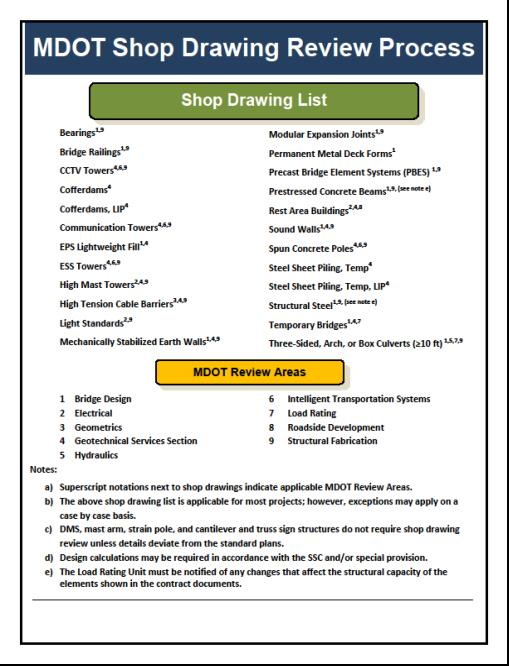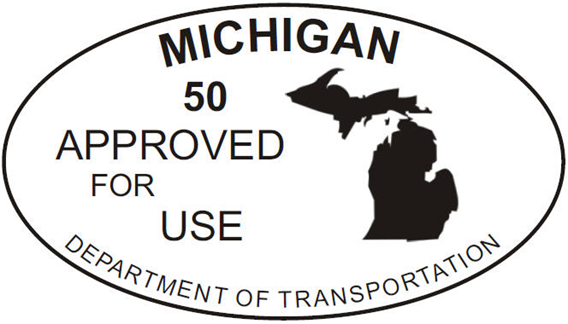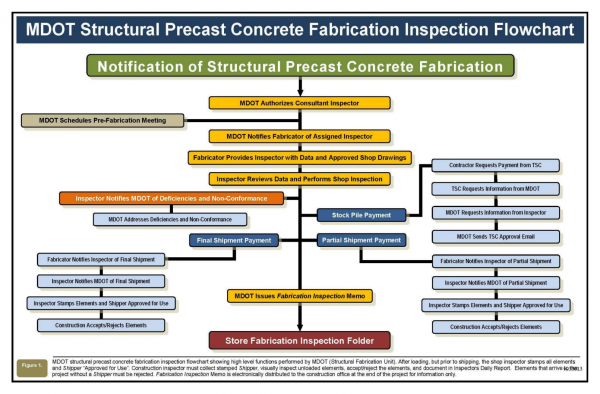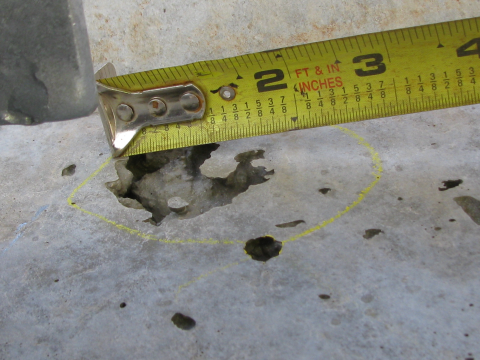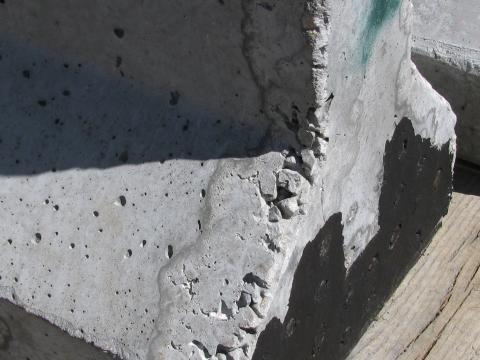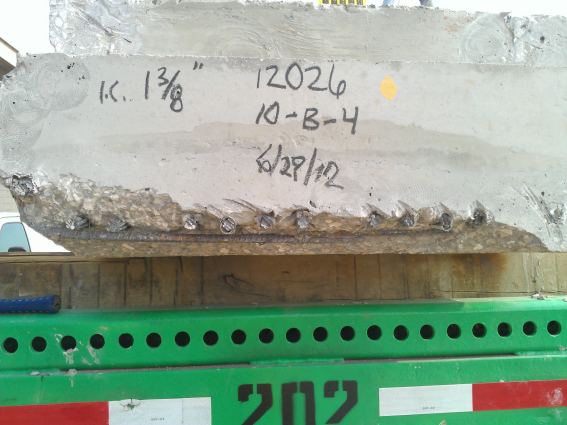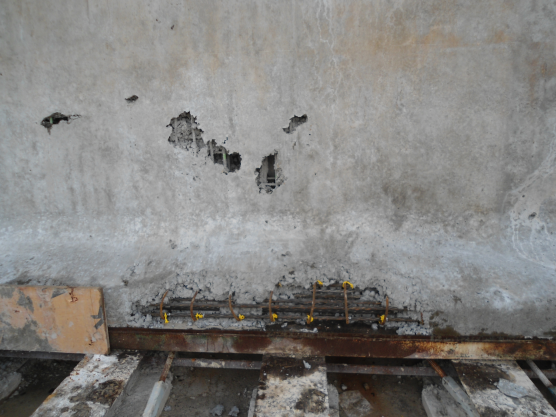Difference between revisions of "708 - Prestressed Concrete"
| Line 106: | Line 106: | ||
{{top}} | {{top}} | ||
| − | ===[[# | + | ===[[#Fabrication of Prestressed Concrete|Fabrication of Prestressed Concrete]]=== |
{{top}} | {{top}} | ||
Revision as of 09:42, 15 May 2014
-This Section Currently Undergoing Substantial Revision-
GENERAL
Structural precast concrete members are cast in forms at a facility certified by the Prestressed Concrete Institute (PCI) that is typically a location other than their final position in the structure. Precast concrete beams are also longitudinally prestressed (bonded pre-tensioned strands) and in the case of side-by-side box beams, are transversely prestressed (post-tensioned strands) as well. Prestressing and post-tensioning of precast concrete elements allows for longer, more efficient spans than traditionally reinforced concrete members by introducing pre-compression into the concrete members. The pre-compression force is typically designed to be larger than the effect of applied loads on the element, and therefore, stresses are well controlled.
Other structural elements that are prestressed include concrete spun poles and in some cases, Prefabricated Bridge Elements and Systems (PBES) other than beams, and sound wall posts and/or panels.
Structural precast concrete elements that are not prestressed include, but may not be limited to, sound wall posts and panels, culverts, and some PBES. Although structural precast concrete elements are typically fabricated off-site, they require on-site inspection to ensure successful forming, casting, transport, handling, and placement into their final position in the structure.
Shop Drawing Submittal
Shop drawings with complete detailed dimensions are submitted to MDOT for review and approval. Approved shop drawings are required prior to the start of fabrication, but MDOT does not check every dimension for accuracy. The submission is reviewed to ensure it is complete and in general conformance with the contract plans. The Contractor is solely responsible for the correctness of shop drawings. Errors found during the review of the shop drawings will be pointed out by MDOT but undiscovered errors are the Contractor's responsibility.
It is the responsibility of the MDOT Design Project Manager (PM) to ensure their project’s shop drawings are being reviewed by all applicable technical reviewers. This process is outlined in Chapter 10 of the MDOT Bridge Design Manual. Figure 708.1-1 and Figure 708.1-2 below summarize MDOT’s electronic shop drawing review process and provides a listing of shop drawings to be reviewed with annotations indicating which MDOT Review Areas need to be involved in their review. Note that this shop drawing listing is general in nature and is applicable for most projects; however, exceptions may apply on a case by case basis and it is the responsibility of the PM to ensure the shop drawings are being reviewed by all applicable parties.
Allow the fabricator or supplier to work directly with MDOT Technical Review Areas to expedite the review of the shop drawings. Contact the Bridge Field Services Structural Fabrication Unit with questions.
The contractor/fabricator shall submit to the Engineer the shop drawings in electronic format according to subsection 104.02 of the Standard Specifications for Construction. The Bridge Design Engineer will coordinate review of the drawings and stamp “Approved.” The approved drawings will be distributed according to the Bridge Design Manual.
Approved Shop Drawing Distribution
Upon receipt of the approved shop drawings from the Bridge Design Engineer, the Engineer shall forward them to the Contractor.
Upon receipt of the shop fabrication and erection drawings at the project office, the inspector will check each sheet against MDOT’s general plans. Particular attention should be directed to span lengths.
Upon completion of the work, the contractor shall furnish the Department one set of complete set of shop drawings on a medium approved by the Department.
Prestressed Concrete Elements
Prestressing, refers to the process of pulling steel tendons in the beam into tension before the concrete is placed in the forms. After the concrete has hardened, the stressed tendons are released and transmit a compressive stress to the concrete. This offsets tension forces on the concrete and increases the load-carrying capacity of the beam. The result is similar to pressing on the ends of a set of books in order to pick up the whole set of books at once.
Beams
The Department uses four general kinds of prestressed concrete beams:
- Side by side box beams
- Spread box beams
- AASHTO I-girders (Types I-IV)
- Bulb-tee girders (e.g. Michigan 1800 girders)
Prestressed concrete beams vary in width, length, and depth. In general, deeper beams will span longer distances for the same loading conditions. Likewise, deeper beams used for the same span length may have wider beam spacing, and thus carry larger loads.
Another beam type that has occasionally been used is the bulb-T beam. This beam shape can be a more effective section due to its larger bottom flange that allows more prestressing strands to be used. It also features a wider top flange that makes the shape more stable during handling, transport and erection.
Prestressing
Prestressing is generally defined as the preloading of a structure, before application of service loads, to improve its performance in specific ways. Precast concrete elements can be prestressed by pre-tensioning or post-tensioning. Pre-tensioning and post-tensioning are subcategories of prestressing and refer to whether the strands are tensioned before concrete placement or after concrete placement, respectively.
- 1) Pre-tensioning: Is typically performed at the fabrication facility by using hydraulic jacks to tension seven-wire steel strands in the beam casting bed before the concrete is placed. After the concrete has reached its minimum required release strength, the tensioned strands are released by cutting at each end, which transmits a compressive force to the concrete via bond between the strands and concrete. This offsets tensile stresses in the concrete from dead load and live load and increases the load-carrying capacity of the beam.
Pre-tensioning is typically used with beams and girders, although it can be used with other elements such as soundwall posts and panels, and other types of PBES such as precast pier caps, precast deck panels, etc. Concrete spun poles are also prestressed.
- 2) Post-Tensioning: Is performed similarly to pre-tensioning but the tensioning of the strands takes place after the concrete has been placed and cured, and the post-tensioning force is distributed to the concrete via mechanical anchorages. The most common application for post-tensioning in the Department is with side by side box beams. After side by side box beams are erected the grouted keyways between the beams are filled with non-shrink grout and cured. Typically the same seven wire strand used in pre-tensioning is grouped to make a tendon and then placed transverse to the beams centerline through ducts in the intermediate diaphragms. In some cases, more rigid steel rods are used for post-tensioning instead of seven wire strands. The quantity of ducts and the number of strands per duct are proportional to the beam length and depth. After hydraulic jacks are used to tension the tendons to the proper load, the force is locked in and the ducts are filled with non-shrink grout. Post-tensioning side by side box beams reduces differential deflection between adjacent beams and allows more effective live load distribution. Post-tensioning can also be used to transmit a compressive load in pier caps, decks, and PBES in order to offset tensile forces in the element.
Concrete Spun Poles
Prestressed concrete spun poles are used to mount cameras and other Intelligent Transportation System (ITS) equipment at high elevations in order to provide the proper vantage point. Similar to beams, strands are pre-tensioned and then the forms are rotated at a high speed to create a pole that is hollow in the middle.
Prefabricated Bridge Elements and Systems (PBES)
PBES can refer to either singular precast elements such as deck panels, footings, columns, pier caps, abutments, etc., or a system that contains multiple elements such as beams with a portion of the deck already attached. The connections between PBES elements or between PBES elements and cast in place elements are of utmost importance. One of the primary advantages of prefabricated elements is the speed at which they can be constructed which minimizes disruption to traffic. If the connections are not properly laid out or constructed, significant delays can result. Therefore, it is important for connection details to be checked by both the Contractor and the Inspector on-site prior to concrete placement or connection of elements, to ensure proper fit-up. All the necessary connection details should be in the design plans.
The use of templates by the Contractor and fabricator is encouraged. At the fabricator’s plant the dimensions should be checked by both the fabricator’s quality control (QC) personnel and the department’s (QA) quality assurance personnel. The Contractor and Inspector are also encouraged to work closely with the fabricator’s QC and the department’s QA to ensure construction goes as smooth as possible.
Connection methods for PBES include, but are not limited to:
- Grouted keyways or pockets
- Grouted mechanical splice sleeves
- Post-tensioning
Soundwalls
Sound walls, or noise abatement walls, can be detailed differently but typically are constructed of two types of elements, panels and posts. Both the panels and posts may be precast and prestressed or precast with conventional steel reinforcement.
Fabrication of Prestressed Concrete
Shop Inspection
The Structural Fabrication Unit will conduct a prefabrication meeting with the fabricator when deemed necessary. Prefabrication meetings are generally scheduled when the fabrication is more complex in nature or the fabricator is new to working with the Department but can be held for any project.
The Engineer should be notified at least one week prior to the beginning of fabrication.
Quality assurance inspection is performed on most structural precast concrete elements such as prestressed beams, culverts over 10’, sound wall posts and panels, MSE wall panels, concrete spun poles, and other prefabricated bridge elements for accelerated bridge construction. The Department’s quality assurance program is implemented by Bridge Field Service’s Structural Fabrication Unit to perform shop inspection at structural precast concrete fabrication facilities nationwide.
Throughout the fabrication process the shop inspector will inspect the materials and fabricated elements for conformance to Department specifications, collect all documentation regarding the fabrication, and verify Buy America provisions were met. If problems arise during the fabrication, the shop inspector will contact the Structural Fabrication Unit for resolution. Once fabrication is complete and the elements are ready to be shipped to the project site, the shop inspector will stamp the elements as well as the shipping documents “Approved for Use”. See Figure 708.2. The inspector then submits all fabrication documentation to the Bridge Field Services Structural Fabrication engineer for placement into the corresponding ProjectWise folder. See Figure 708.3 for more information on the fabrication inspection process.
Addressing Deficiencies
As part of the shop inspection process, the MDOT shop inspector will note the condition of structural precast elements as they are removed from the forms, and note if corrective repairs are required prior to approving the element for use on MDOT projects. These repairs are typically done prior to being shipped to the project site, however, there are some circumstances where repairs will be required on site, so the construction inspector should be familiar with common deficiencies. The Structural Fabrication Unit has developed, with the assistance of the Materials Section, repair procedures to assist with evaluating fabricator proposed concrete repairs to fabricated structural precast concrete elements for MDOT projects.
Fabricated structural precast concrete elements may contain defects from the fabrication process or can be damaged from the removal of formwork, handling, and shipping. The fabricator is required to notify the MDOT QA shop inspector of all defects and/or damages to fabricated elements and propose a repair procedure to MDOT for acceptance. MDOT will thoroughly evaluate the proposed procedure and provide a response. The repair procedure will be either be approved, rejected or approved as noted. The fabricator must receive MDOT approval before performing the repair. Structural precast concrete repairs can be generalized into the following categories:
- Minor Surface Defects (air holes, minor honeycombing, gouges etc.) See Figure 708.4 through Figure 708.06 for minor surface defects
- Major Surface Defects (moderate honeycombing, etc.)
- Minor Damages (spalls, cracks, broken corners, etc.) See Figure 708.7 through Figure 708.8 for examples of minor damages
- Other, which includes major damage and elements subject to rejection. See Figure 708.9 and Figure 708.10 for example of major deficiencies.
The repair of deficiencies to the satisfaction of the Structural Fabrication Unit, or rejection of elements for major deficiencies will occur at the fabrication facility prior to shipment to the site. It is important to note the Approved for Use stamp on all structural precast elements prior to incorporation into the project.
MATERIALS
-Reserved-
CONSTRUCTION
DELIVERY OF STRUCTURAL PRECAST ELEMENTS
When prestressed or non-prestressed structural precast structural concrete elements arrive on the job site, inspect them before they are unloaded. Check ends of each beam for a stamp or tag stating “Approved for Use.” If the beams are delivered to the project site without an approval stamp or tag, reject the beams. If the beams are approved for use, a memorandum will be sent to the TSC from Bridge Field Services stating the approval of each beam and verification of all material certifications and test results. According to Section 4.04 of the MDOT Materials Quality Assurance Procedures Manual prestressed concrete fabrication has been approved for use by MDOT when the following two part process is met:
- A. Fabrication Inspection Acceptance: Structural elements must be inspected by the shop inspector after they are loaded for shipping. The elements must be stamped “Approved for Use” prior to shipping if they meet contract requirements. Additionally, the shop inspector must stamp at least five copies of the Bill of Lading that is prepared by the fabricator. The approval stamp is for use by the Department and does not relieve the contractor of their responsibility to meet contract requirements.
- B. Visual Inspection Acceptance: The engineer must collect one copy of the stamped Bill of Lading and use it to verify the delivered structural elements. Additionally, the engineer must verify that the elements are stamped and visually inspect them for signs of damage that may have occurred as a result of shipping and handling. This visual inspection should be documented in the Inspector’s Daily Report (IDR).
The Engineer must visually inspect the product for signs of damage that may occur as a result of shipping and handling. This visual information should be documented on the inspector’s daily report. Look for deficiencies in the beams in the form of cracks, honeycombing, spalls, or cold joints. Crack widths can be measured with a crack comparator as seen in Figure 708-11. Bring any damage to the attention of the Engineer and make a record of the damage in the daily report. Take measurements of crack width and length as well as spall measurements and photographs. Also note in the daily report when the beams arrive in good condition. If there is any concern regarding whether beams were approved for use or whether damage is acceptable, contact Bridge Field Services.
Per Section 105 of the Standard Specifications for Construction, the Engineer reserves the right to reject any shipped product that shows visual signs of damage or does not meet specification requirements.
Considerable care should be exercised when handling structural precast concrete elements. In many cases, there is no way to repair a damaged element short of re-fabrication. Prestressed beams should be kept in an upright position at all times, as the beam’s own dead weight counter acts the internal prestressing force to keep the beam stable. The method of stockpiling and transporting members is covered in detail in subsection 708.03 of the Standard Specifications for Construction. Beams shall be supported at two points no more than 3 feet (1 m) from the ends of the beams.
Check beam markings and compare to the beam layout sheet in the plans. Make sure the beams are placed in the right location and direction. They may fit in more than one place but there is only one correct location and direction for each beam.
Lifting devices, usually loops of seven wire strand, are cast into the member and these should be the only attachment used when moving a beam. The lifting device must have adequate capacity to lift the beams and set them in place. Never lift the beam near the center. If the beam has to be set down before being placed, never allow it to be supported at the center. Crib it under the ends. The prestressing forces pulling in on the ends of the beam hold up the dead weight of the beam. If the beam is supported or lifted at the center, the prestressing forces will cause the beam to crack.
Once the structural precast concrete element has been accepted on the job site, the inspector should verify that the material is stored properly prior to installation. Below is a list of items the inspector should check regarding storage of structural precast concrete elements:
- Support beams off the ground to prevent moisture and deleterious material intrusion
- Support beams across the full width on two battens, each greater than 4 inches wide. Support stacked beams, one above the other along the same vertical plane at each ends of the beams.
- Support the beams on level, stable ground, avoid storing beams near side slopes, or areas near heavy construction traffic
- Do not support the beam at more than two points
- Taller, long span I-beam shapes may need to be laterally braced on site
- Members are to be stored in an upright position and should be thoroughly braced to avoid overturning, which may damage the member itself, adjacent members or material, or injure personnel in the immediate vicinity.
- Related items such as bearings and bridge railing should also be protected from damage, dirt, and corrosion.
Ensure the lifting devices are removed once the beam has been placed in its final position on the substructure.
Erection of Box Beams
To ensure that box beams will fit properly on the substructure units; the beam widths should be checked. Beam bearing pads must be shimmed (when necessary) in an approved manner during erection to provide full bearing contact with the bottoms of the beams. This needs to be checked on every box beam. Box beams may camber more than anticipated, or may experience transverse rotation such that they do not sit flush on the sole plates, which are typically beveled to accommodate camber and vertical alignment angles. Note in the daily report when the beam erection has been completed.
At expansion bearings, ensure the beams line up with the position dowel holes, and ensure the holes are filled with hot poured rubber sealant type filler at least 3 inches above the position dowels. Ensure the remainder of the hole is filled with Type H-1 grout. Ensure holes at fixed bearings are filled with Type H-1 grout.
For side by side box beams, the beams should be set with spaces between them as specified on the plans or shop drawings and with the seal washers placed around the transverse post tensioning conduit holes. The space between the beams should be completely filled, full depth, with R-2 grout mortar and cured for at least 48 hours. Ensure the contractor does not grout when temperatures are below 40° F. The deck width should be measured by the Contractor as soon as the beams are set to assure that post tensioning rods or strand will be fabricated to the proper length.
All hardware dimensions must be as shown on the plans or shop drawings. Tendons or rods for post-tensioning should be tensioned with calibrated jacks according to a Contractor-supplied calibration chart showing the corresponding jack pressures and elongations necessary to gradually build up to the required post-tensioning force. After the post-tensioning is complete, ensure the conduit is flushed with water, then compressed air. The tendon or rod holes will be grouted under pressure with Type E-1 grout for steel tendons or rods as described in subsection 708.03B of the Standard Specifications for Construction.
Do not stand behind the jacking machine or rod holes during jacking procedures. If a tendon or rod snaps, it can cause serious injury.
Erection of I-Girders and Michigan 1800 Girders
Beam bearing pads must be shimmed (when necessary) in an approved manner during erection to provide full bearing contact with the bottoms of the beams. Similar to box beams, beveled sole plates are also typically required for I-girders. This needs to be checked on every beam. Note in the daily report when the beam erection has been completed.
I-Girders and especially Michigan 1800 girders can be more prone to sweep or transverse deflection. For this reason they should be rigidly blocked in place to ensure proper spacing between beams before any deck or diaphragm forming.
Erection of Spun Concrete Poles
Spun concrete poles typically have less concrete clear cover from the outside of the element to the prestressing strands than prestressed beams. Pay particular attention to any cracking and bring it to the attention of the Engineer. During installation, the poles must only be lifted and stored using the locations and methods shown on the approved shop drawings or manufacturer’s instructions. Spun concrete poles must be safely secured after being placed in the drilled shaft installation before the concrete foundation is poured and cured.
Erection of Sound Walls
In most cases the sound wall panels are attached to the posts using tongue and groove joints. It is important during erection that the panels are lowered slowly into position and do not crack or spall the posts. If the posts are prestressed, and contain grout pockets, the grout pockets at the ends of the posts must be filled with non-shrink grout and should be free of cracks. In order to properly inspect prestressed posts a ladder should be used to visually inspect the tops of the posts. Any cracking whether from damage or shrinkage, or spalling, should be cause for concern as the horizontal surface will be subject to moisture and chloride intrusion leading to rapid deterioration of the posts.
MEASUREMENT AND PAYMENT
There are three methods of payment for structural precast concrete elements as described below. All three methods are shown in Figure 708-03. No method of payment relieves the Fabricator or Contractor from damage due to transporting, storing on the project site, or erecting the elements. Additional information on payment can be found in Section 109 of the Standard Specifications for Construction.
Stockpile payment
After the Contractor has requested stockpile payment and the TSC has verified that all of the paperwork has been properly submitted (e.g. proof for full payment to subcontractors) contact the Bridge Field Services Structural Fabrication Unit to verify that the stockpiled materials meet project specifications and/or fabricated elements have been approved for use up to the date of the request. The Structural Fabrication Unit will then send the TSC notification that stockpiled materials requested for payment are in conformance with the project specifications.
Partial Shipment Payment
After the Fabricator has shipped a portion of the structural concrete elements to the project site verify that the shipping documentation and elements have been stamped approved for use, and inspect the product for signs of damage that may have occurred as a result of shipping and handling. If the shipping documentation and elements are stamped approved for use and there is no shipping and handling damage partial shipment payment may be made. The approved for use stamp indicates that all materials and processes during fabrication were according to specifications; a Fabrication Inspection memo will be sent to the TSC after final shipment.
Final Shipment Payment
As with partial shipments, after the Fabricator has sent the final shipment of the structural concrete elements to the project site verify that the shipping documentation and elements have been stamped approved for use, and inspect the product for signs of damage that may have occurred as a result of shipping and handling. If the shipping documentation and elements are stamped approved for use and there is no shipping and handling damage partial shipment payment may be made. The approved for use stamp indicates that all materials and processes during fabrication were according to specifications; a Fabrication Inspection memo will be sent to the TSC after final shipment.

